Blacksmith, Chromis punctipinnis
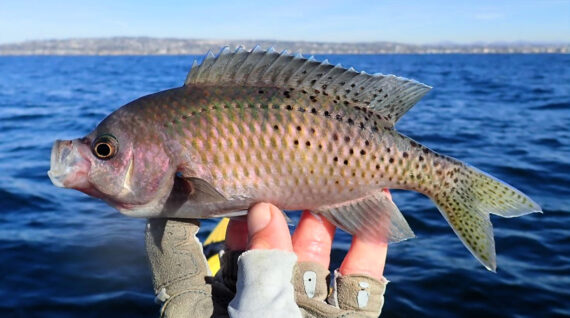 Blacksmith, Chromis punctipinnis. Fish caught from coastal waters off San Diego, California, December 2020. Length: 15 cm (5.9 inches). Catch, photograph and identification courtesy of Ben Cantrell, San Diego, California.
Blacksmith, Chromis punctipinnis. Fish caught from coastal waters off San Diego, California, December 2020. Length: 15 cm (5.9 inches). Catch, photograph and identification courtesy of Ben Cantrell, San Diego, California.
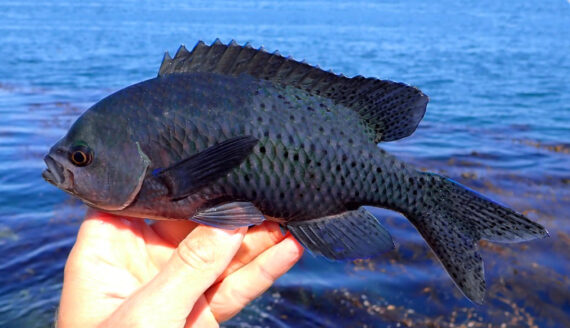 Blacksmith, Chromis punctipinnis. Fish caught from coastal waters off Santa Cruz, September 2023. Length: 17 cm (6.7 inches). Catch, photograph and identification courtesy of Ben Cantrell, Peoria, Illinois.
Blacksmith, Chromis punctipinnis. Fish caught from coastal waters off Santa Cruz, September 2023. Length: 17 cm (6.7 inches). Catch, photograph and identification courtesy of Ben Cantrell, Peoria, Illinois.


 Blacksmith, Chromis punctipinnis. Fish caught from coastal waters off San Diego, California, January 2020. Length: 17.5 cm (6.9 inches). Catch, photograph, and identification courtesy of Ben Cantrell, San Diego, California.
Blacksmith, Chromis punctipinnis. Fish caught from coastal waters off San Diego, California, January 2020. Length: 17.5 cm (6.9 inches). Catch, photograph, and identification courtesy of Ben Cantrell, San Diego, California.
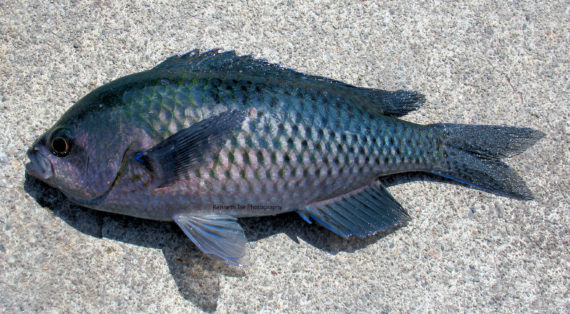 Blacksmith, Chromis punctipinnis, Male. Fish caught from coastal waters off Avalon, Catalina Island, California, August 2012. Length: 18 cm (7.0 inches). Catch, photograph and identification courtesy of Kenneth Tse, Toronto, Ontario, Canada.
Blacksmith, Chromis punctipinnis, Male. Fish caught from coastal waters off Avalon, Catalina Island, California, August 2012. Length: 18 cm (7.0 inches). Catch, photograph and identification courtesy of Kenneth Tse, Toronto, Ontario, Canada.
 Blacksmith, Chromis punctipinnis, Male. Fish caught from coastal waters off Avalon, Catalina Island, California, August 2012. Length: 20 cm (7.9 inches). Catch, photograph, and identification courtesy of Josh Leisen (joshadventures.com), Gaylord, Michigan.
Blacksmith, Chromis punctipinnis, Male. Fish caught from coastal waters off Avalon, Catalina Island, California, August 2012. Length: 20 cm (7.9 inches). Catch, photograph, and identification courtesy of Josh Leisen (joshadventures.com), Gaylord, Michigan.
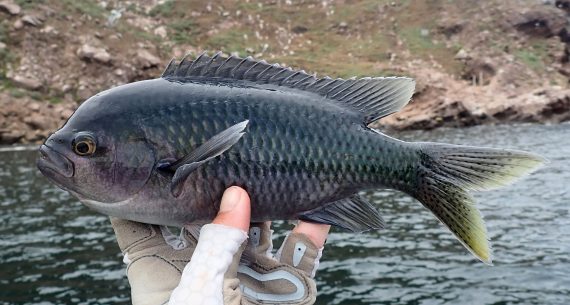 Blacksmith, Chromis punctipinnis, Male. Fish caught from coastal waters off the Coronado Islands, Baja California, July 2019. Length: 23 cm (9.1 inches). Catch, photograph, and identification courtesy of Ben Cantrell, San Diego, California.
Blacksmith, Chromis punctipinnis, Male. Fish caught from coastal waters off the Coronado Islands, Baja California, July 2019. Length: 23 cm (9.1 inches). Catch, photograph, and identification courtesy of Ben Cantrell, San Diego, California.
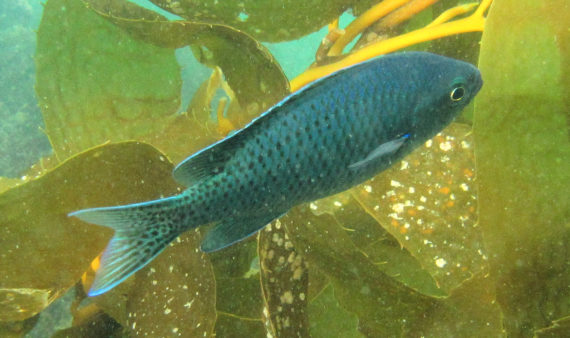 Blacksmith, Chromis punctipinnis. Underwater photograph taken in coastal waters off La Jolla, California, September 2017. Length: 20.0 cm (7.9 inches). Photograph courtesy of Bob Hillis, Ivins, Utah.
Blacksmith, Chromis punctipinnis. Underwater photograph taken in coastal waters off La Jolla, California, September 2017. Length: 20.0 cm (7.9 inches). Photograph courtesy of Bob Hillis, Ivins, Utah.
The Blacksmith, Chromis punctipinnis, is a member of the Damselfish or Pomacentridae Family, and is known in Mexico as castañeta herrera. Globally, there are eighty-four species in the genus Chromis, of which eight are found in Mexican waters, five in the Atlantic and three in the Pacific Ocean.
The Blacksmith has an oblong and compressed body that are widest at the dorsal fin origin and tapers toward the tail. They have a body depth that is 33% to 37% of standard length. They are very dark dorsally, being blackish with a blue tinge and transition to a lighter blue-gray ventrally. Their scales have black spots from the mid-body to the caudal fin and their caudal and dorsal fins also have black spots. Most fish have a blue border on their anal, caudal, and dorsal fins. Juveniles are more brightly colored than adults and are blue-gray transitioning to yellow-orange at the rear. Their anal fin has 2 spines and 10 to 12 rays; their caudal fin is forked with pointed lobes; and, their dorsal fin has 13 spines and 11 or 12 rays. Their body is covered with large scales.
The Blacksmith is a demersal species that is found inshore in and around steep banks and rocky reefs and in kelp forests at depths up to 61 m (200 feet). They also frequent man-made structures including bridge pilings, docks, oil platforms, and piers. They reach a maximum of 30.5 cm (12.0 inches) in length. Adults consume algae and zooplankton whereas juveniles eat small crustaceans and juvenile squid. They are preyed upon by larger fish, numerous sea birds, and various marine mammals including the California Sea Lion, Zalophus californianus, and the Pacific Harbor Seal, Phocavilulina richardii. They are non-migratory and highly territorial and will aggressively attack intruders. They have a symbiotic relationship with the Señorita, Oxyjulis californica, which provide them with cleaning services. They are known to retreat in close knit aggregations and rest in rocky crevices during the night. Juveniles are pelagic and travel in schools. Reproduction is oviparous with distinct pairings during breeding. Eggs are demersal and attach to the substrate. Males guard and aerate the eggs until they hatch. The Blacksmith Damselfish is poorly studied with very limited information available about their lifestyle and behavioral patterns including specific details on age, growth, longevity, movement patterns, diet, habitat use, and reproduction.
The Blacksmith is a resident of Mexican waters of the Pacific Ocean but has a limited distribution being found from Guerrero Negro, Baja California Sur, northward along the central and northwest coasts of Baja.
The Blacksmith is a straightforward identification and cannot be confused with any other species due to its coloration and body profile.
From a conservation perspective the Blacksmith is currently considered to be of Least Concern with stable, widely distributed populations. They appear to be resilient to coastal development. Although small in stature they are considered to be an excellent food fish and sold commercially on a limited basis. They are difficult to hook via hook and line and many are taken by spear fishermen.